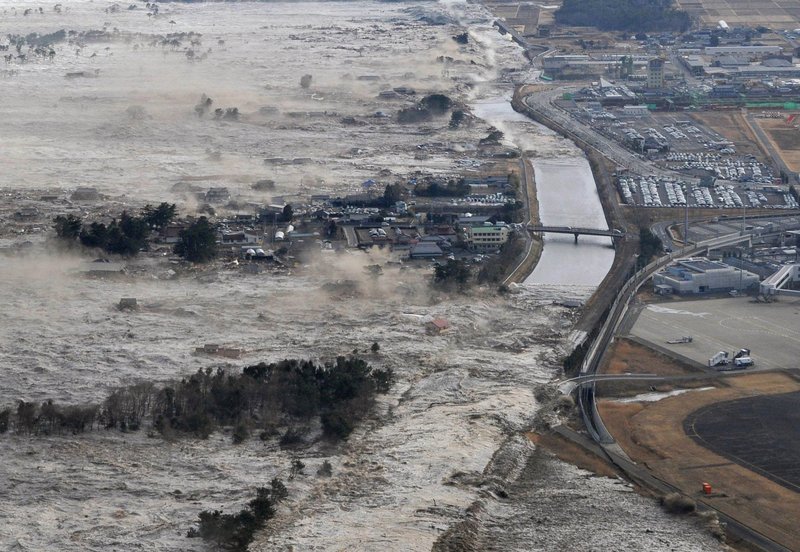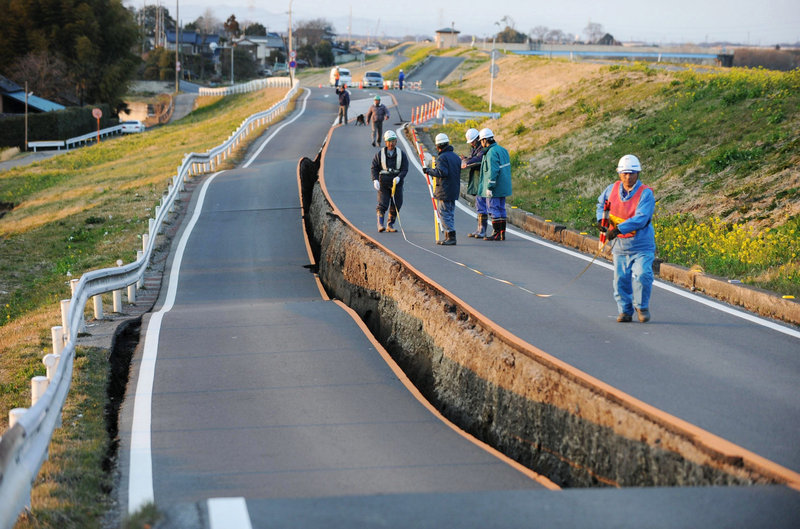LOS ANGELES – After the earthquake, it took 45 minutes for the tsunami to reach the coast of Japan — 45 minutes of knowing, of waiting, of bracing.
When it came, they were all glued to their televisions — a Jesuit priest in New York, an engineering professor in rural Oregon, a geophysicist in San Diego. What unfolded had never been broadcast live before: a 13-foot wall of mud that belittled human achievement, folding houses inside out, propelling yachts across miles of rice fields, rupturing oil refineries, sweeping trains from their tracks and killing hundreds.
By now, we’re versed in bearing witness to the aftermath of disaster: limbs jutting out from collapsed buildings in Haiti, survivors using laundry to spell out “HELP US” on their rooftops after Hurricane Katrina. This was different — a disaster unfolding in visceral, wrenching real time, for viewers who were alternately spellbound and tortured by their inability to do anything about it.
Japan’s plight came on a sunny Friday afternoon; the magnitude 8.9 earthquake, the largest to strike the area in recorded history, hit at 2:46 p.m. local time. Japan is not only an advanced economy but one of the most wired nations on Earth; at one point Friday, there were 20 tweets a second coming out of Tokyo.
The nation, meanwhile, is a voracious consumer of information, and media outlets and government officials had plenty of time after the quake to get their cameras in place — as well as estimates of where the waves would hit and when, which proved quite accurate.
It was a confluence of events and circumstance that helped us watch, or forced us to watch, in a new way. When it was over, the images seemed to have bent both edges of the spectrum of comprehension: Scientists questioned the limits of science. And believers questioned the limits of faith.
Deepak Chopra, the spirituality and wellness author, said he was surprised to find that his first thoughts as he watched the disaster unfold were of Hiroshima and Nagasaki, the Japanese cities leveled by American nuclear bombs at the end of World War II. Imagine, he thought, if Americans had watched those bombs explode on live television. “Would we be as tolerant as we are that we and many other countries are stockpiling nuclear weapons?” he asked.
“We are living in a very interesting time,” he said. “What is emerging is that you cannot separate yourself emotionally or in any other way from what is happening anywhere in the world. We are a global community. We need to feel this pain. We need to act upon it. We need to realize that we are now entangled with everything that happens — everywhere.”
Many said the only experience comparable to watching the tsunami was watching the destruction in lower Manhattan on Sept. 11, 2001. Indeed, some of the images cut close to the bone for Americans — in particular, the disturbing video of victims trapped in tall buildings, waving white shirts out of open windows in a desperate attempt to flag down rescuers, smoke curling around them.
“You are totally powerless against a memory like that,” said J. Jon Bruno, the Episcopal bishop of Los Angeles. “It is embedded into your being.”
Ken Reeves, director of forecasting operations at Accuweather.com, was captivated and horrified watching video of cars trying to steer clear of the debris field, with no high ground in sight. He watched a group of people standing on a bridge as rising, churning water sent boats lurching toward them. He said he couldn’t help but think: “My God, get off the bridge!”
For years now, Americans have reveled in an unlikely and incongruous notion on television: “reality that is unreal,” said Father Jim Martin, a Jesuit priest in New York City and the culture editor of America, the weekly Catholic magazine.
Here was something different: reality that was real, more gripping and terrible than anything even the most creative or cynical television producer could conjure. “It’s the shock of seeing real reality instead of fake reality. It seems paradoxically unreal,” Martin said.
“A lot of these reality shows are based on watching people suffer — watching them suffer physically, watching them suffer financially. It’s important to recognize that we don’t have to create suffering in this world. There is suffering in this world.”
Seafarers have long returned with tales — often dismissed as apocryphal — of the ocean abruptly reaching up and snatching at anything in its path. The 1883 explosion of the volcanic island Krakatoa unleashed waves that were estimated to have killed tens of thousands. “Some argue that there’s even descriptions of tsunamis in the Bible,” Reeves said.
These events, though, are extremely rare and occur only in low-lying areas with the requisite mix of geophysical conditions.
The 2004 tsunami event in the Indian Ocean, which killed 230,000 people in 14 nations, marked a dramatic turning point in awareness of the potential for titanic waves — in part because it was captured on cell phone videos and other devices — though nothing approaching this level of documentation. That episode also prodded many scientists to ratchet up their efforts to understand tsunamis and communicate their danger.
But that science is still very much in its infancy, so much so that researchers in the northwestern United States and British Columbia still rely in part on Native American word-of-mouth legend to understand the physics of past events there.
“You’re talking about things that can occur 300 years apart,” said Dr. Frank Vernon, a research geophysicist at the Scripps Institution of Oceanography in San Diego. Vernon said that as he watched the tsunami come ashore, he was unable to divorce the scientist in him from the humanist. “You want to reach out and help, and you can’t do anything — except maybe better prepare for the next round,” he said.
Currently, scientists are able to predict landfall — but only after a tsunami has begun offshore, and typically by using a relatively rudimentary system of buoys that measure fluctuations in wave levels. They know far less about how tsunamis are created, or why some offshore earthquakes create them and some don’t, or how the waves will react once they reach land.
No tsunami has ever been documented to this degree. Harry Yeh, a professor of engineering at Oregon State University, was watching a cooking show with his wife on Japanese-language television when the live news reports broke into the broadcast. His heart broke for his native Japan, he said — but he instantly recognized that within the small, tight-knit community of scientists who study tsunamis, “this was extremely intriguing and amazing.”
Send questions/comments to the editors.




Success. Please wait for the page to reload. If the page does not reload within 5 seconds, please refresh the page.
Enter your email and password to access comments.
Hi, to comment on stories you must . This profile is in addition to your subscription and website login.
Already have a commenting profile? .
Invalid username/password.
Please check your email to confirm and complete your registration.
Only subscribers are eligible to post comments. Please subscribe or login first for digital access. Here’s why.
Use the form below to reset your password. When you've submitted your account email, we will send an email with a reset code.